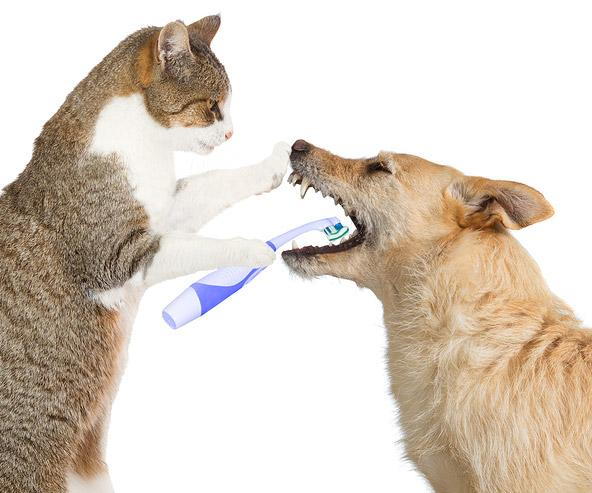- When to start? As soon as possible. Eight to 12 weeks old is best. Pets don’t need maintenance this young, but by starting when your pet is young and impressionable, they will become familiar with the routine when the permanent teeth erupt. It is a good idea to stop brushing while your pet is losing its baby teeth as the mouth will be a bit sore and your poking around with the brush will cause more pain. Once all the permanent teeth are in you can pick up where you left off.
- The first step is to work with your pet’s mouth. With a little patience your pet will soon accept your attention. Make it fun for both of you. Use a lot of love and especially praise to gain their confidence. Try to have your practice sessions at the same time each day so your pet gets into a routine. Late in the evening often works well, as everyone involved is generally in a quiet mood then. If your pet is highly motivated by food, try just before dinner with the meal acting as a reward for co-operating.
- Start by handling the muzzle and tickling the lips and soon you will be able to rub the teeth and gums with your finger. Put a few drops of water, flavored with garlic or garlic salt for dogs and tuna juice for cats, in the mouth daily. They will soon look forward to this treat.
- Next, use a washcloth or piece of pantyhose, wrapped around the end of your finger and flavored as above, to gently rub the teeth.
- Finally, use a soft toothbrush to brush the teeth. There are several veterinary brushes available and many human brushes are well suited to animal use as well. Hold the brush at a 45 degree angle to the tooth and brush back and forth or from gum to tip. Brushing the tongue side of the teeth is less critical. Use the garlic water or tuna juice. Make it a game.
- There is an ever growing selection of veterinary tooth washes, pastes and gels. Your veterinarian can help you select the one best suited to your situation. These products may (or may not) increase the effectiveness of your home-care program but remember, it’s the brushing which does most of the cleaning. Brushing should be done daily for best results. Less than 4 times a week will have little if any effect. Human tooth paste is to be avoided as it will cause stomach upset if swallowed. Baking soda, with its very high sodium content can be dangerous to older patients. Hydrogen peroxide can be too harsh for the gums and must not be swallowed.
- It helps to give mildly abrasive foods and toys. Visit www.vohc.org for products with valid research to back their claims. Focus on products that are accepted to control plaque over those that just have a tartar claim. Avoid natural bones, antlers, dried cow hooves and hard nylon toys and large rawhide toys as these are hard enough to fracture teeth. If you would not want me to hit you in the knee-cap with it, don’t let your dog chew on it!
- By following a consistent program of home-care, you will greatly improve you pet’s dental health. This will mean fewer professional cleanings, less tooth loss and a happier, healthier pet. However, please remember that there is no substitute for professional veterinary care. We must work as a team to ensure a long and happy life for your pet.
- For more information, please have a look at this paper on our website – http://www.toothvet.ca/PDFfiles/HomeCarePack.pdf
Thank you for letting us help maintain your pet’s dental health.

